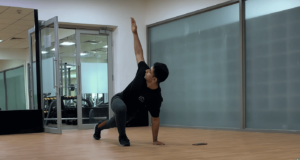Summary
- Dynamic stretches like arm circles and cardio exercises such as jumping jacks elevate your heart rate and improve flexibility
- Foam rolling alleviates muscle tightness, while yoga flows enhance mental focus and body alignment
When it comes to fitness, warming up is often overlooked. Many people jump straight into their workouts, eager to crush their goals or short on time, and skip this crucial step. But skipping a warm-up can lead to unnecessary injuries, reduced performance, and longer recovery times. A proper warm-up not only preps your body but also sets the tone for a more effective and enjoyable workout. Here, we explore eight comprehensive warm-up routines designed to keep you safe, flexible, and ready to perform.
1. Dynamic Stretching Routine
Dynamic stretching involves controlled, movement-based stretches that gently take your joints and muscles through their full range of motion. This type of warm-up is excellent for preparing your body for various types of exercise, from running to weightlifting.
Example Routine:
- Arm Circles: 10 repetitions in each direction.
- Leg Swings: 10 swings per leg (front to back and side to side).
- Torso Twists: 10 twists, focusing on smooth, controlled movement.
- Hip Circles: 10 rotations in each direction.
Benefits:
- Enhances flexibility and joint mobility.
- Gradually increases your heart rate and circulation.
- Activates muscle groups needed for your workout.
2. Cardiovascular Warm-Up
Cardio-based warm-ups are ideal for elevating your heart rate and loosening your muscles. These routines are particularly useful before high-intensity or endurance workouts.
Example Routine:
- Jumping Jacks: 1 minute.
- High Knees: 30 seconds.
- Butt Kicks: 30 seconds.
- Light Jog or March in Place: 2 minutes.
Benefits:
- Prepares your cardiovascular system for increased activity.
- Improves oxygen delivery to your muscles.
- Reduces stiffness and tension in your body.
3. Foam Rolling (Self-Myofascial Release)
Foam rolling helps release muscle tightness and improves blood flow to targeted areas. It’s especially helpful for those who experience muscle stiffness or engage in high-impact sports.
Example Routine:
- Calves: 30 seconds per leg.
- Quads: 30 seconds per leg.
- Hamstrings: 30 seconds per leg.
- Upper Back: Roll gently for 30 seconds.
Benefits:
- Reduces muscle soreness and tightness.
- Improves range of motion.
- Prepares muscles for better activation during exercise.
4. Yoga-Inspired Flow
A yoga-inspired warm-up combines stretches and gentle movements to center your mind and body. This is particularly beneficial for workouts like pilates, dance, or any activity requiring balance and focus.
Example Routine:
- Downward Dog to Upward Dog: 5 repetitions.
- Cat-Cow Stretch: 10 repetitions.
- Low Lunge with Twist: Hold for 15 seconds on each side.
- Child’s Pose: Hold for 20 seconds.
Benefits:
- Increases flexibility and mental focus.
- Promotes deep, steady breathing.
- Loosens tight muscles and aligns your posture.
5. Plyometric Warm-Up
Plyometric movements are dynamic and explosive, making them perfect for prepping your body for sports, sprinting, or HIIT workouts.
Example Routine:
- Bounding: 10 repetitions per leg.
- Skater Hops: 10 hops per side.
- Power Knees: 20 repetitions.
- Quick Lateral Shuffles: 30 seconds.
Benefits:
- Activates fast-twitch muscle fibers.
- Enhances coordination and agility.
- Prepares your body for high-impact movements.
6. Joint-Specific Mobility Drills
These drills target specific joints to improve range of motion and reduce stiffness. They’re particularly beneficial for older adults or those with sedentary lifestyles.
Example Routine:
- Neck Rolls: 5 rotations each direction.
- Shoulder Shrugs: 10 repetitions.
- Wrist Circles: 10 rotations each direction.
- Ankle Rolls: 10 rotations per foot.
Benefits:
- Enhances joint health and flexibility.
- Reduces risk of joint-related injuries.
- Improves movement quality.
7. Sport-Specific Warm-Up
Tailoring your warm-up to the activity you’re about to perform can maximize performance and reduce injury risk. For instance:
Example Routine for Runners:
- Walking Lunges: 10 steps per leg.
- Leg Swings: 10 swings per leg.
- Short Strides: 3-5 sets of 20 meters.
Example Routine for Weightlifters:
- Bodyweight Squats: 10 repetitions.
- Push-Ups: 10 repetitions.
- Light Deadlifts with a Resistance Band: 10 repetitions.
Benefits:
- Engages muscles and joints specific to your workout.
- Improves neuromuscular coordination.
- Builds confidence before intense activity.
8. Breathing and Mindfulness Routine
Sometimes, the best warm-up is mental. Incorporating breathing exercises and mindfulness can help you focus and reduce pre-workout anxiety.
Example Routine:
- Diaphragmatic Breathing: 10 deep breaths, focusing on filling your belly with air.
- Box Breathing: Inhale for 4 seconds, hold for 4 seconds, exhale for 4 seconds, and pause for 4 seconds. Repeat 5 times.
- Visualization: Spend 1 minute visualizing a successful and injury-free workout.
Benefits:
- Calms the nervous system and reduces stress.
- Improves oxygen delivery and lung capacity.
- Boosts mental clarity and readiness.
Conclusion
Warming up isn’t just a prelude to your workout—it’s an essential component of injury prevention and overall performance. Whether you prefer dynamic stretches, foam rolling, or a yoga flow, there’s a warm-up routine to suit your needs. Take the time to incorporate one (or a combination) of these eight warm-up routines into your fitness regimen. Your body will thank you, and your workouts will feel smoother and more effective.







